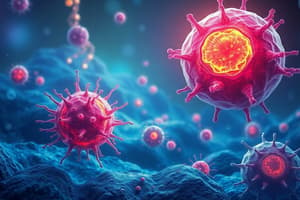Podcast
Questions and Answers
What type of cells are always unicellular?
What type of cells are always unicellular?
- Prokaryotic cells (correct)
- Plant cells
- Animal cells
- Eukaryotic cells
Which of the following organelles is NOT found in animal cells?
Which of the following organelles is NOT found in animal cells?
- Chloroplast (correct)
- Golgi apparatus
- Mitochondria
- Nucleus
What is a primary component of the cell wall in fungi cells?
What is a primary component of the cell wall in fungi cells?
- Chitin (correct)
- Pectin
- Lignin
- Cellulose
Which of these organisms is classified as a eukaryote?
Which of these organisms is classified as a eukaryote?
What is a unique characteristic of archaea compared to bacteria?
What is a unique characteristic of archaea compared to bacteria?
Which of the following accurately describes eukaryotic cells?
Which of the following accurately describes eukaryotic cells?
What distinguishes prokaryotic cells from eukaryotic cells?
What distinguishes prokaryotic cells from eukaryotic cells?
Which statement about protist cells is true?
Which statement about protist cells is true?
Flashcards are hidden until you start studying
Study Notes
Cell Types
- Prokaryotic and eukaryotic cells represent two primary cell types on Earth.
- Prokaryotes are always unicellular organisms, while eukaryotic cells can be unicellular or multicellular.
Eukaryotic Cells
- Eukaryotic cells are present in all living organisms made of more than one cell, including animals, plants, fungi, and protists.
- Eukaryotic cells are characterized by membrane-bound organelles such as a nucleus and mitochondria.
Animal Cells
- Fundamental units of all animals, including birds, fish, reptiles, mammals, and amphibians.
- Contain membrane-bound organelles: nucleus, mitochondria, Golgi apparatus, and endoplasmic reticulum.
- Surrounded by a plasma membrane.
Plant Cells
- Building blocks of plants, characterized by features common to eukaryotic cells.
- Possess a cell wall, which is absent in animal cells, providing structure and support.
- Contains organelles such as chloroplasts for photosynthesis.
Fungi Cells
- Cells contain structures and organelles found in both plant and animal cells.
- Lack the ability to perform photosynthesis.
- Have a cell wall primarily composed of chitin, a polysaccharide distinct from the cellulose found in plant cell walls.
Protist Cells
- Possess all membrane-bound organelles found in animal cells, with some types containing chloroplasts for photosynthesis.
Prokaryotic Cells
- Smaller and simpler than eukaryotic cells, lacking membrane-bound organelles.
- Always unicellular and categorized as either bacteria or archaea.
- The basic structural features of bacteria and archaea are similar, but they have different compositions and characteristics.
Bacteria Cells
- Unicellular prokaryotic organisms without membrane-bound organelles.
- Do not contain a nucleus, mitochondria, endoplasmic reticulum, or Golgi apparatus.
Archaea Cells
- Unicellular prokaryotes sharing several structural similarities with bacteria.
- Differ in biochemical and genetic composition from bacteria despite superficial similarities.
Studying That Suits You
Use AI to generate personalized quizzes and flashcards to suit your learning preferences.




